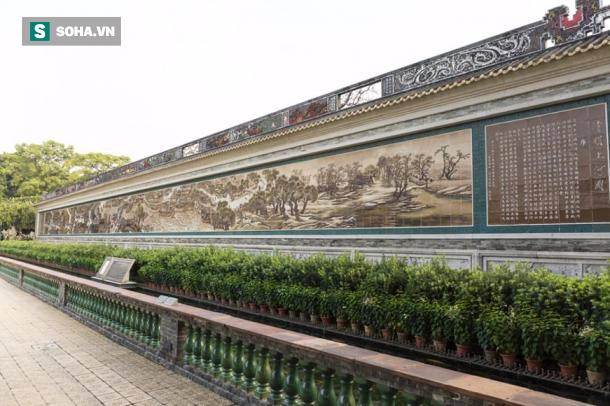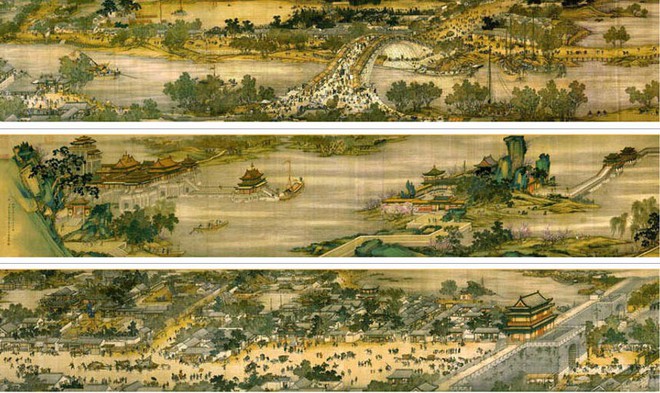“Qing Ming Dynasty Map” is one of the valuable works of art in China. Many residents were ready to stand in line for 6 hours to admire it.
As a result, the painting “Map of Thanh Minh Thuong Ha” (means an image of the riverside in the time of Thanh Minh), is over 5 meters long. This is a paint roller, one of China’s most famous works of art, composed in the 12th century.
The precious painting is compared to the painting “Mona Lisa” by the great painter Leonardo da Vinci, it is therefore nicknamed “Mona Lisa of China”. This painting delicately depicts the landscape inside and outside Bien Kinh, the capital of the Song Dynasty (i.e. Khai Phong, present-day Ha Nam Province) during the festival of the Thanh Minh period .
The “Thanh Minh Thuong Ha Map” is very valuable and “fragile”, so that the public rarely admires the real paintings, but only copies.
The owner of this beautiful painting is Truong Trach Doan (1085-1145). It was he who painted the picture of Thanh Minh on a long roll, about 24.8 cm high and about 5.29 meters long. Viewers can watch the image from right to left.
This is one of the rare occasions when the public has the opportunity to admire this masterpiece as they often only see reproduced paintings, as the original is extremely valuable.
The last exhibition of “Qingming Xiaotu” dates back to 2002 in Shanghai. This ancient painting mainly depicts and depicts images such as people, animals, rivers, boats and houses in the countryside, suburbs and city centers.
“Thanh Minh Thuong Ha Map” looks like a photo of the bustling and bustling moment of Bien Kinh during Tiet Thanh Minh, a traditional festival in China. According to the China Online Museum website, “thanh minh” is translated as “pure”.
The researchers said the title of the painting is linked to the festival on the occasion of Tiet Thanh Minh. However, Valerie Hansen, professor at Yale University (USA) said that another translation of the word “clarification” is “peace and order”.
Therefore, the title of this painting could also mean “peace across the river”.
The beautiful patterns of the painting “Thanh Minh Thuong Ha Map”
According to experts, the “Thanh Minh Thuong Ha Map” image consists of three main parts. The first is the countryside on the right side, with business and other activities in between, followed by a spectacle of the river, roads and bridges spanning the river.
The image “Map of Thanh Minh Thuong Ha” has 3 main parts. Photo: Old origins
On the left side is the bustling city view and entrance. In the rural area, there is a small bridge with streams, crop fields and locals including pig herders, goats and farmers.
In addition, viewers may also notice a road leading into the city center, where there are more houses and densely populated residents.
In particular, looking closely at the city in the photo, we will see a panoramic view of a large river with many boats coming and going from the top of the city to the main streets and border gates, many people and houses. house also appeared gradually.
Street shops sell a wide range of products including food, wine, kitchen utensils, musical instruments, gold and silver lanterns. In addition, they also sell items such as bows and arrows, decorations, medicines, paints, needles and dyed fabrics.
However, the most important part of the painting “Thanh Minh Thuong Ha Map” is located near the center, where there is a bridge that spans the river.
People standing on the deck seemed to be reporting in concern that a nearby boat with a tall mast might collide with the deck. Meanwhile, the area to the left of the image is the area around the entrance to the city.
There are more shops, tax offices and residents lining up the boats.
People seem very busy, some walk, stand in the street, ride horses, while others carry large baskets on their shoulders or use horse carts, camels and donkeys to transport goods.
The buildings and trees in this area look better and vary as well, from simple huts to large buildings such as temples, inns, and administrative buildings.
The painting “Map of Thanh Minh Thuong Ha” was exhibited at the Imperial Palace (Forbidden City) in September 2015, making the public in this country very enthusiastic and ready to queue until 6 am to see the original version of the ” treasure “nicknamed the” Mona Lisa of China “.
According to the Women of China page, the Palace Museum also plans to continue displaying the original of this “treasure” painting in 2020 due to the great public interest.





